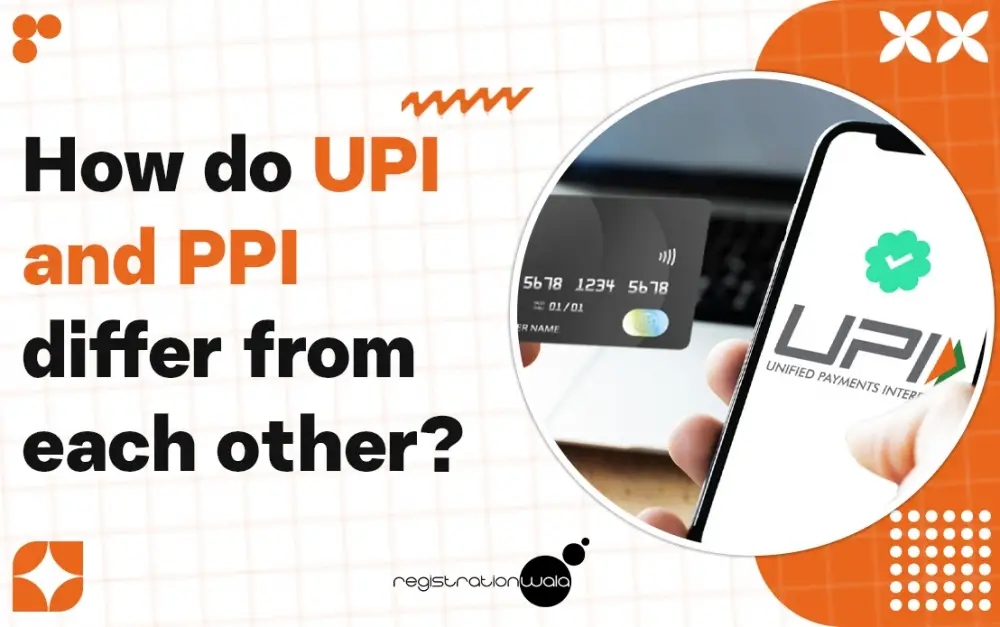How do UPI and PPI differ from each other?
- May 09, 2024
- Registrationwala

- Home
- /
- Knowledge Base
- /
- News & other businesses
- /
- Blog
- /
- How do UPI and PPI differ from each other?
How do UPI and PPI differ from each other?
Both UPI and PPI are crucial mechanisms for digital payments. While UPI stands for ‘Unified Payments Interface’, PPI stands for ‘Prepaid Payment Instrument’. In this blog post, we will discuss the difference between UPI vs. PPI.
What is UPI?
Unified Payments Interface, or simply UPI, is a real-time payment system which allows instant transfer of funds between bank accounts in India. It enables the user to link multiple bank accounts to a single mobile app such as Paytm, Mobikwik, etc. and provides a seamless and secure platform for making payments across India. The National Payments Corporation of India (NPCI) is responsible for regulating UPI.
UPI was launched on April 11, 2016 in India by the Reserve Bank of India (RBI) and the National Payments Corporation of India (NPCI) in collaboration with various banks and payment services providers. UPI has made the process of digital payments simpler and allowed for easy and convenient money transfers due to which it has been successful in promoting financial inclusion.
According to the RBI, “the ‘UPI’ has become the most talked about fast payment system not only in India but across the world. It is the biggest contributor to the growth of digital payments in India. The share of UPI in digital payments has reached close to 80 per cent in 2023. At a macro level, the volume of UPI transactions increased from 43 crore in CY-2017 to 11,761 crore in CY-2023.”
Major UPIs in India
Here is a list of major UPI apps in India and their respective sponsor banks:
Source: Razorpay
What is PPI?
Prepaid Payment Instruments, simply known as PPI, refer to the digital payment solutions that allow users to store their money digitally. PPIs come in various forms like mobile PPI wallets, virtual accounts and prepaid cards. These instruments can be used by the users for loading their funds into them, and using them for multiple transactions which includes online shopping, payment of bills, and money transfers. PPIs offer a convenient and secure way of making digital payments without the requirement of traditional banking methods and cater to a wide range of users.
By offering an alternative method for digital payments, PPIs complement UPI. PPIs, such as mobile wallets or prepaid cards, are linked to UPI and allow the users to load funds in their wallets and use them for making UPI transactions. This combination enhances the versatility of digital payments and makes them more convenient.
What are the Types of PPIs in India?
There are three types of Prepaid Payment Instruments in India namely Closed-System PPIs, Semi-Closed PPIs and Open-System PPIs. We have explained them below for you.
Closed-System PPIs
The Closed-System PPIs are only meant to facilitate the buying of goods and services from the issuing agency and do not permit the feature of cash withdrawal. This category is not considered as a payment system which needs permission from the RBI. Closed-System PPIs cannot be used for payments/settlements for services which are considered as third-party services.
Semi-Closed PPIs
Semi-Closed PPIs refer to PPIs which are licensed by the banks (permitted by RBI) and non-banks (authorized by RBI). The financial services under this type include remittance infrastructure and overseas transactions. Cashwithdrawal is not permitted in case of semi-closed PPIs, irrespective of whether they are issued by banks or NBFCs. These PPIs can generally be used at any merchant location having a specific contract with the issuer to accept the PPIs as an instrument of payment.
Open-System PPIs
Debit cards and credit cards are viewed as the most commonly used PPIs. These PPIs enable you to make a cash withdrawal. They are licensed by the banks with RBI’s approval and are used by any retailer who wants to pay for services and products, which includes payment services, remittance services and so on. The cash withdrawals can be made from Business Correspondents (BCs), Point of Sale Terminals, and ATMs of Banks. However, it is necessary to be cautious while withdrawing cash using a credit card since you might be charged a high rate of interest from the day you withdraw the cash.
What makes PPI different from UPI payments?
PPI transactions use prepaid payment methods like mobile wallets, gift cards and other online payment methods. While UPI transactions are real-time transfers between two bank accounts. PPIs can be used for paying bills, shopping online and other activities. However, PPIs are most commonly utilized for Peer-to-Peer transfers and merchant payments. As compared to the PPI, UPI has a higher payment limit.
Conclusion
Both UPIs and PPIs allow individuals and businesses to make payments digitally. However, both of them have their own distinct features and limitations. Both UPIs and PPIs play an important role in the promotion of financial inclusion and helped to transform India into a nation which is digitally empowered. If you liked this post, make sure to check out the rest of our informative blog posts.
- 1199 views
